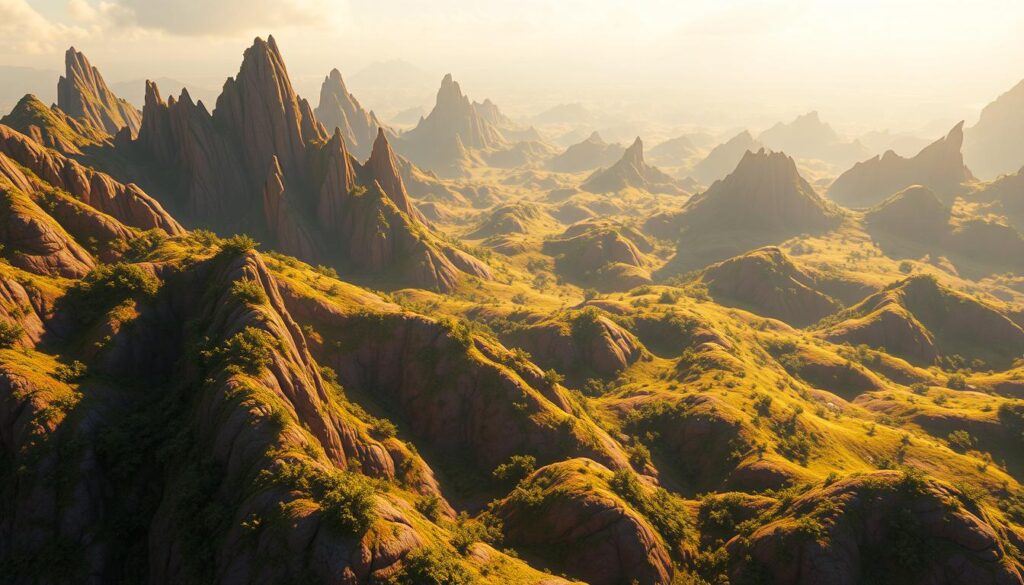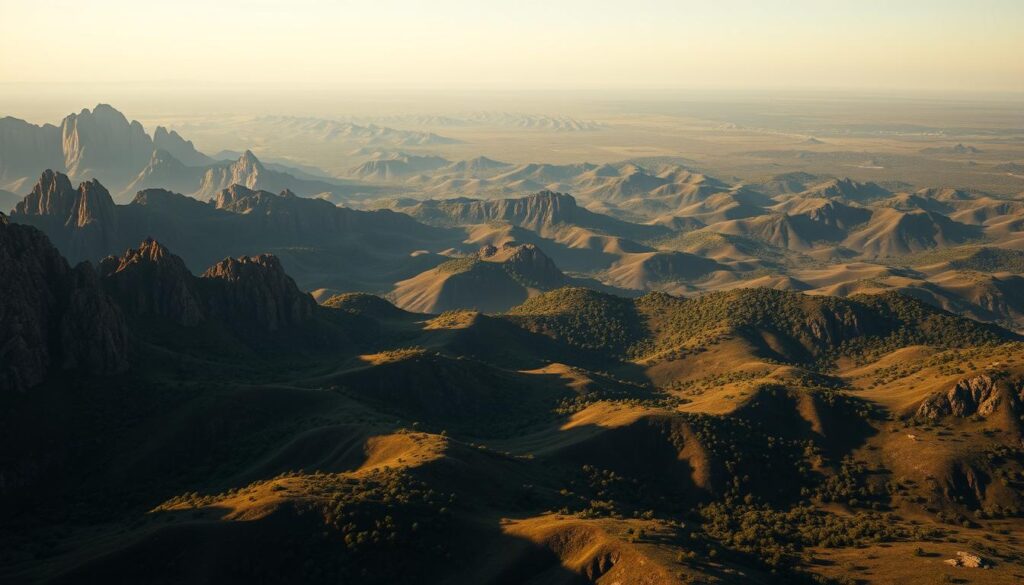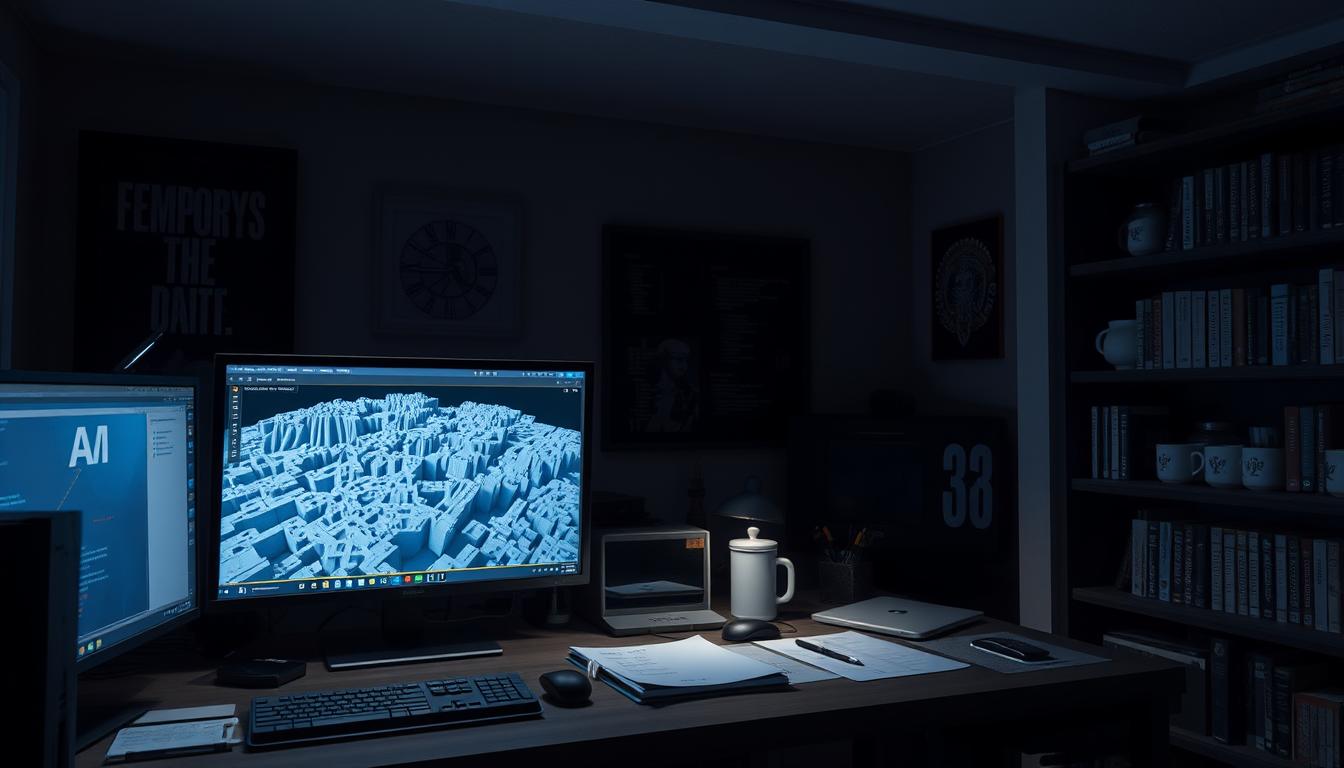Ever wondered how game developers make vast, immersive worlds? The secret is procedural terrain generation. This set of techniques and tools shapes open-world maps. We’ll look at key terrain management tools for creating stunning environments and better player experiences.
These tools offer real-time rendering and work with top game development tools. Let’s explore the exciting world of terrain generation together.
Introduction to Procedural Terrain Generation
Procedural terrain generation is a game-changing method in game development. It uses algorithms to create landscapes on the fly. This is different from traditional methods where every detail is hand-crafted.
This approach makes creating terrain fast and varied. Developers use math and noise functions to make detailed landscapes. These landscapes make virtual environments feel more real.
This method also saves time and boosts creativity in design. The unique landscapes it creates keep players interested. Features like mountains, valleys, and rivers can change with each play, making every session fresh.
As developers dive deeper into procedural generation, the possibilities for interactive worlds grow. The blend of technology and creativity in terrain design is shaping the future of gaming.

Understanding the Importance of Terrain in Open-World Maps
The role of terrain in open-world design is huge. It sets the mood and affects how players move around. Players love to explore these vast worlds, making the terrain’s details key to a great experience.
Terrain design boosts player immersion. Features like hills and valleys guide players’ actions. A well-thought-out terrain layout encourages players to explore, finding hidden spots and stories.
Unique terrain features add to gameplay and storytelling. For example, mountains can be dangerous, while valleys are peaceful. This mix of terrain and story shows how important good terrain design is in keeping players engaged.

Key Features of Effective Terrain Generation Tools
Modern terrain generation tools have key features that make game development better. They help create amazing environments. This makes it easier for developers to make high-quality landscapes.
Real-time Rendering Capabilities
Real-time rendering is a big deal in these tools. It lets developers see changes right away. This makes the development process more interactive.
Artists can see how their changes affect the terrain instantly. This leads to quicker adjustments and a smoother workflow.
Support for Various Environmental Effects
These tools also support many environmental effects. They let developers add realistic weather, dynamic lighting, and atmospheric conditions. This makes virtual worlds come alive.
Such effects draw players into the game. They make the landscape feel alive and engaging.
Integration with Game Engines
Being able to work well with game engines is crucial. Tools that integrate well with Unity and Unreal Engine make things easier. This lets developers focus on creativity, not technical issues.
World Creator: A Leading Tool
World Creator is a top choice for making procedural terrains. It offers photorealistic rendering, making environments look amazing. The tool also has a real-time path tracer for better visuals, giving users great results.
Photorealistic Rendering Engine
World Creator’s main feature is its advanced rendering engine. It uses HDRI maps for light and shadow effects that look real. It also has effects like water, fog, and depth of field to make landscapes feel real.
Advanced Erosion Models
World Creator’s erosion models are key for realistic terrains. They help designers show how landscapes change over time. This makes terrains look real and engaging for players.
Managing Terrain Generation in Procedural Maps
Effective terrain management is key to improving procedural maps in game development. Designers must balance automated processes with manual tweaks. This ensures landscapes meet gameplay needs.
Using algorithms to automate terrain generation is a smart strategy. It lets designers fine-tune parameters for better control. This mix boosts creativity, making diverse terrains possible without too much manual effort.
Feedback loops are vital for refining terrain management. By analyzing player interactions, developers can improve landscape generation. This ensures the game feels immersive and engaging.
Having a clear organizational system in the development process is crucial. It helps categorize terrain types like mountains and valleys. This makes landscapes coherent and visually appealing.
Advanced tools with real-time rendering are very helpful. They let developers see changes instantly. This is important for keeping the design on track and enhancing gameplay.
Successful terrain management needs teamwork. It combines artistic vision with technical skills. By using automation and customization, developers can make procedural maps that improve the player’s experience.
Flax Editor: A New Contender in Terrain Generation
The Flax Editor has become a key player in terrain generation. It offers tools to make development more efficient and creative. Its focus on easy workflows and user-friendly interfaces makes it stand out.
Automatic Topology Creation
This feature creates terrain topology automatically. It lets developers set up their terrain quickly with little manual work. This saves time and effort, letting designers focus on their creative ideas.
Seamless Integration with Existing Tools
The Flax Editor works well with many external tools in game development. This makes workflows smoother, allowing for easier asset import and editing. It helps teams use their resources better and explore the Flax Editor’s features.
World Machine: Essential for AAA Game Development
World Machine is a key tool in AAA game development. It uses a graph-based terrain generation interface. This makes it easy for developers to see how terrain changes with each adjustment.
This visual approach helps developers understand terrain shaping better. It makes it simpler to get the desired effects and improve game environments.
Graph-Based Approach to Terrain Generation
World Machine’s strength is its graph-based terrain generation. Users can build complex landscapes by linking nodes that represent different processes. Each node changes specific terrain aspects.
This makes it simple to tweak parameters and see the effects right away. It speeds up the design process, allowing for quick prototyping and adjustments. This is vital for AAA game development.
Macros for Erosion and Masking
World Machine has macros that boost workflow efficiency, especially for erosion and masking. These macros simulate natural erosion, creating realistic landscapes. This enhances the gaming experience.
Texture masking also lets developers control texture application on terrain. This gives artists and developers the tools to create diverse, visually stunning worlds.
Common Challenges in Procedural Terrain Generation
Developers often face many challenges in making terrain for games. Performance issues and keeping the terrain realistic are big concerns. It’s key to make the game run smoothly and look amazing.
Performance Issues
Keeping an eye on how well the game runs is very important. Tools need to handle complex tasks without slowing down the game. Too many details can make the game slow, which can upset players.
Developers must find ways to keep the game fast. They need to know a lot about the computer’s abilities and the game’s software. This helps make sure the game runs well.
Maintaining Realism and Natural Look
Making landscapes look real is another big challenge. It’s important to find a balance between using algorithms and making the terrain look natural. Developers use special techniques to create varied terrain.
But, it’s crucial that the terrain doesn’t look fake. The goal is to make the terrain feel like a real place. This can really make the game more enjoyable for players.
Techniques for Optimizing Terrain Textures
Optimizing textures is key to better visuals without using too much system power. In terrain generation, splat mapping and layer blending are crucial. They help make terrain textures diverse and engaging, creating a realistic world.
Using Splat Mapping and Layer Blending
Splat mapping lets you use many textures on one surface. It adds depth and variety to terrain. This method makes different ground materials look real.
Layer blending helps textures blend smoothly. It makes the terrain look natural. Using both techniques improves the visual quality a lot.
Texture Baking Best Practices
Texture baking calculates lighting and shadows beforehand. It’s done to make terrain look detailed without slowing down the game. Good texture baking practices balance quality and performance well.
Implementing Water Systems in Terrain Generation
Water systems are key to making game environments feel real. In terrain generation, they add depth and realism. By using realistic water effects and flow, developers can create immersive landscapes.
They can simulate lakes, rivers, and oceans. This makes the game world feel more believable and fun for players.
Creating Realistic Water Effects
Developers use shaders to make water look real. These shaders can show the shimmering of lakes and the movement of oceans. The right lighting makes reflections look even more real.
Flow Dynamics for Rivers and Lakes
Getting water flow right is crucial for rivers and lakes. It lets developers show how water moves naturally. This makes the game world look better and feel more alive.
The Role of Community Feedback in Terrain Tools
Community feedback is key in making terrain tools better. Developers use what users say to improve their software. They listen and change their tools to meet user needs.
When people use terrain tools, they share what works well and what doesn’t. They also suggest new things. This helps create a team effort where everyone feels part of the tool’s growth.
It’s also important for developers to quickly respond to feedback. Keeping in touch with users helps make updates smoother. This way, the tools get better, and users feel valued.
Future Trends in Procedural Terrain Generation
The world of procedural terrain generation is about to change a lot. New AI tools are making it possible to create detailed and realistic landscapes. These changes could make games more exciting and interactive.
Advancements in AI-Driven Tools
AI tools are playing a big role in procedural terrain generation. They use advanced learning to automate complex tasks. This makes creating landscapes faster and more accurate.
AI can look at huge amounts of data to learn what makes a terrain believable. This helps creators make environments that are both surprising and engaging.
Increased Accessibility for Independent Developers
Game development is becoming more accessible to independent developers. They can now use advanced technology without spending a lot. This is thanks to easier-to-use tools and lower prices.
With these changes, more people can join the game development world. This opens up new ideas and possibilities for everyone.
Case Studies: Successful Use of Terrain Generation Tools
In the world of game development, procedural tools have changed how we create game worlds. These tools help make games more realistic and fun. This section looks at some great examples of how games have used these tools to improve the player’s experience.
Exploring Popular Games Developed with Procedural Methods
Many famous games have used procedural terrain generation. Games like No Man’s Sky and Minecraft show what’s possible. They create vast worlds with unique landscapes, offering endless exploration.
Games like Spelunky use random terrain for each play. This keeps the game fresh and exciting.
Lessons Learned from Industry Professionals
Experts share important tips on using terrain generation tools. They say it’s key to test and refine the terrain during development. This ensures it’s high quality and adds to the game.
They also stress the importance of working with artists and designers. This mix of creativity and technology can create amazing game worlds that players love.
| Game Title | Procedural Tools Used | Key Features |
|---|---|---|
| No Man’s Sky | Custom procedural generation algorithms | Endless exploration, unique planetary systems |
| Minecraft | Voxel-based procedural generation | Infinite worlds, customizable environments |
| Spelunky | Randomized level generation | Variety in gameplay, replayability |
Conclusion
Effective tools for managing procedural terrain generation are key in game design. They help create immersive worlds that players love. With new technologies, the future of terrain generation looks bright, full of creative possibilities.
Iterative development is a great way for developers to improve their skills. It helps them meet the changing needs of the gaming world. By trying new things and listening to feedback, they can make terrains that are both real and fun.
As the game industry grows, keeping up with new terrain generation tech is important. By working together and innovating, developers can make games even better. This will make playing open-world games more exciting than ever.
FAQ
What is procedural terrain generation?
Procedural terrain generation uses algorithms to create landscapes in video games. It lets developers build detailed environments without designing every part manually.
Why is terrain important in open-world maps?
Terrain greatly affects the feel and navigation of open-world maps. A good terrain makes the game more immersive and engaging. It also tells the story of the environment.
What key features should I look for in terrain generation tools?
Look for tools that render in real-time and support weather and atmospheric effects. They should also work well with game engines like Unity and Unreal Engine. This makes the workflow smoother and more productive.
How does World Creator enhance rendering capabilities?
World Creator has a powerful real-time path tracer. It supports stunning visuals, HDRI maps, and effects like water and fog. This lets designers make landscapes that look real.
What role does Flax Editor play in terrain generation?
Flax Editor makes creating terrain easy with automatic topology generation. It also works well with other tools. This makes it a great choice for developers who want to work efficiently.
What are the strengths of World Machine in game development?
World Machine is known for its easy-to-use graph-based interface. It lets designers see and change terrain processes easily. Its macros help create complex terrains with erosion effects and texture masking.
What common challenges do developers face in terrain generation?
Developers often struggle with performance issues that slow down the game. They must balance automated generation with realistic features. They also need to optimize textures for good visuals without slowing down the game.
How can developers optimize terrain textures?
Using splat mapping and layer blending can make textures rich and detailed. Texture baking ensures high-quality visuals without using too much system resources. This is key for smooth performance.
Why are water systems important in terrain generation?
Water systems, like lakes and rivers, make the game world feel more real. They simulate water behavior and flow. This adds depth to the environment and makes the game more immersive.
How does community feedback influence terrain generation tools?
Feedback from the community helps improve tools and add new features. It builds a connection between developers and users. This ensures tools meet the needs of creators effectively.
What future trends are expected in procedural terrain generation?
Future trends include better AI algorithms for terrain generation. This will make landscapes more realistic. Also, game development tools will become more accessible to indie developers, allowing them to create detailed environments without big resources.
Can you provide examples of games that successfully use procedural terrain generation?
Games like “No Man’s Sky” and “Minecraft” use procedural terrain generation well. They create engaging environments. Industry experts often share how they use these tools in their work.




